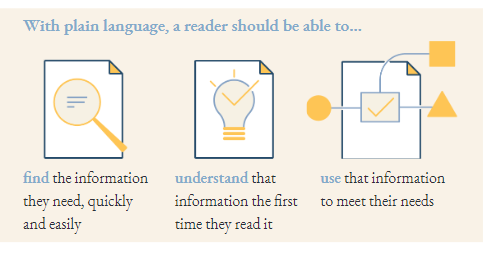1. What is plain language?
Plain language is also called plain writing or plain English. It provides information in a way that means your audience can understand it the first time they read or hear it.
It is related to the concept of universal design, where products and systems are designed in a way that the largest number of people can use them.
Both plain language and universal design are ways to serve the largest number of people with one “product” (document, system, environment). This approach benefits people of all ages and abilities.
With plain language, a reader should be able to…
- find the information they need, quickly and easily
- understand that information the first time they read it
- use that information to meet their needs.

Plain language is more than just tips and tricks for presenting information more clearly. The philosophy behind plain language is that people have the right to understand information, no matter how well they read. With a plain language approach, the responsibility for clear communication is on the writer, not the reader.

